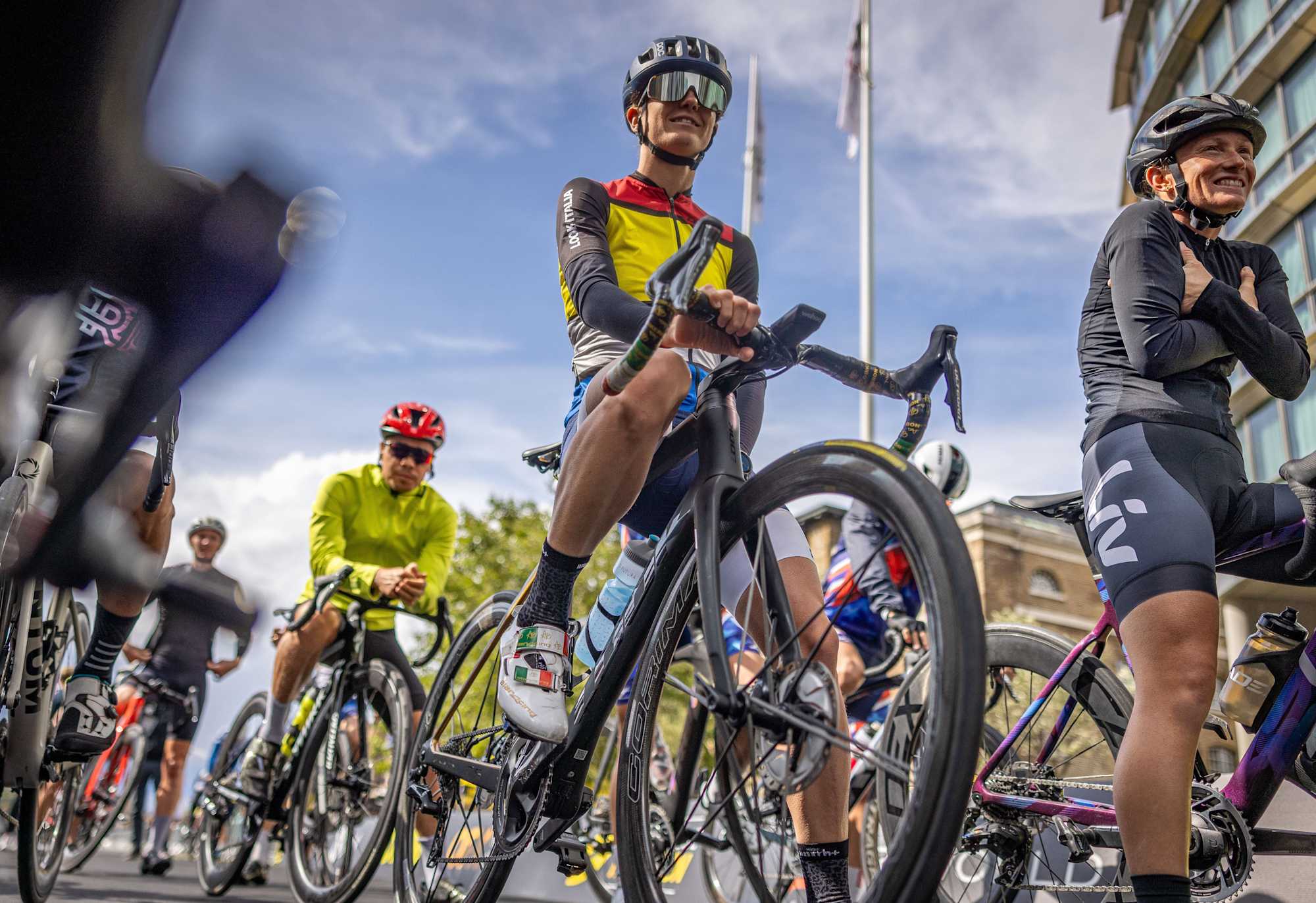Triathlon bikes vs road bikes: What’s the difference & which one should I use for triathlon?

The fact that there’s a mix shows that one isn’t necessarily better than another. Which one you choose to ride comes down to a number of factors, such as personal preference, budget, the demands of the course, and the rules of the event.
They are also not the only choices. As long as a bike is deemed safe, you can ride hybrid bicycles or even mountain bikes – which are the preferred choice for off-road or XTERRA-branded racing, essentially a form of cross-country triathlon.
For this guide though, we will stick to TT bikes and road bikes. We’ll explain some of the key differences, and help you decide which type to pick for your races.
WHAT ARE THE MAIN FEATURES OF A TRIATHLON BIKE?
Like most bikes, triathlon bikes have two wheels, gears, brakes, and gain forward momentum through pedal power. But they are marked out by some distinguishing features.
Most notable is the TT cockpit, the front part of the bike, incorporating the handlebars, where you change gears and apply the brakes.
Triathlon bikes also tend to have distinctive frame geometry – often with a more upright seat post – that pushes the rider further forward over the bottom bracket.
You might also see other features such as integrated hydration systems within the bike frame or disc and deeper-dished wheels for enhanced aerodynamics.
WHAT IS THE DIFFERENCE BETWEEN A ROAD BIKE AND A TRIATHLON BIKE?
Here we’ve broken down some specific differences between a road bike and a TT bike.
COCKPIT/HANDLEBARS
The set-up on a triathlon bike is perhaps the most obvious difference to a regular road bike because it’s a big change from the familiar curved ‘drop’ handlebars that road cyclists have been racing on for decades.
Instead, a triathlon bike has parallel ‘TT’ bars that jut forward (sometimes curved, S-shaped, or angled depending on preference). Forearm rests or cups support the rider’s body weight as they lean forward and grip the bars.
The design is so the rider can get into a low, aerodynamic position – meaning they can cut through the wind more easily. The gear changers are often at the end of the tri-bars.
The other part of the bars is the base bar with bull horns to the side where the brakes are typically situated. These help the rider steer and sit-up to brake when necessary.
GEOMETRY: SEAT POST AND FRAME
The geometry of a TT bike is also noticeably different from road bikes. Seat posts on triathlon bikes tend to be steeper than traditional road bikes, bringing the rider’s hips further forward so they can comfortably lean over the cockpit and grip the tri bars.
Not all triathlon bikes have seat posts – some funky-looking beam bikes do without – although they still tend to have the saddle positioned more forward in comparison to road bikes.
When it comes to choosing the correct size of TT bike, there are lots of considerations. It’s not just about rider height, but torso length and flexibility. It’s best to try before you buy.
WHEELS
While you can fit different types of wheels to both road bikes and TT bikes, it’s more common to find disc wheels, tri-spoke wheels or deep-dished wheels on a triathlon bike.
This is to help increase straight-line speed through aerodynamics, which for time trial racing often trumps the extra agility a road bike – with regular spokes – might give you for riding in a pack or cornering quickly.
UCI-LEGAL
Triathlon bikes tend to vary greatly in their looks compared to road bikes. This is partly because in triathlon anything goes. Unlike cycling events, triathletes and tri bikes are not governed by UCI rules which dictate elements such as frame geometry.
As such, you find a lot of experimentation with triathlon bikes as manufacturers produce models to try and gain an edge. An example might be removing parts of the frame to make it lighter, or using the frame as the hydration reservoir so you can fill it with fluid and drink directly through a straw without leaving your aero tuck
WHY IS A TRIATHLON BIKE DIFFERENT?
A triathlon bike is designed to be as fast as possible in a race against the clock. While you are still competing against other triathletes, TT bikes are used in the non-drafting format which means that unless overtaking they should be ridden at least a minimum distance from the bike in front (12m in Ironman pro races but varies depending on the event).
They are designed to be as aerodynamic as possible, partly because they are not shielded from the wind by other riders. Given the requirement to react and brake suddenly shouldn’t be as essential as it would be if riding in a group, it also means handling is not such a priority. Hence, the brake levers tend to be set back from where the time trial bars are gripped.
Triathlon is also not governed by UCI rules. The UCI – Union Cycliste Internationale – is the governing body of cycling that sets the rules for how bikes are set up. These are technical but based on safety and uniformity, so essentially a bicycle looks like a bicycle! With triathlon not subject to these rules, triathlon time trial bikes can be engineered differently, and you’ll see an array of different frame designs and set-ups in an attempt to maximise any aerodynamic advantages.
WHEN SHOULD I USE A TRIATHLON BIKE?
Triathlon bikes should only be used in non-drafting triathlon races and not draft-legal races where competitors can cycle close to one another or in packs.
Most events amateur triathletes take part in are designated non-drafting. The main difference is that you cannot ride in a group and must abide by rules stating how much of a gap you should leave to the cyclist in front (unless overtaking).
All long distance events including Ironman and Ironman 70.3 races tend to be non-drafting, meaning you can use a TT bike – although it’s not mandatory. Most standard or Olympic distance events for amateurs are also non-drafting.
Where TT bikes may be outlawed is in sprint distance racing, particularly at representative level. For example, if you want to represent the GB age-group team at a sprint distance championship.
Check before signing up for a race. If you turn up with a triathlon bike for a draft-legal race, you won’t be allowed to take part for safety reasons.
WHAT OTHER EQUIPMENT WILL YOU NEED FOR A TT/ TRIATHLON BIKE?
Although the bike may look different, the good news is that you don’t need any different equipment to ride it. The fundamentals can stay the same, including the pedals and the way you clip-in, so you can race with your tri shoes or normal bike shoes. There are some other considerations, however:
TIME TRIAL HELMETS
You’ll often find triathletes riding a time trial bike opt for a dedicated time trial helmet over a road helmet. These are designed with aerodynamics in mind. They tend to have less ventilation than a road helmet, are often heavier and may have an extended tail to align with your spine when tucked into the aero position on the ride and help with optimal airflow.
HYDRATION
Other equipment that may differ includes how hydration is managed. Hydration and nutrition set-ups vary from time trial bike to time trial bike. Some will have cages on the frame or behind the saddle that cater for regular sized drink bottles just as with a road bike. Others may have a reservoir in the frame you need to fill, or come with a specific aero bottle with a narrow shape that fits between the TT bars, for example. If you’re riding a TT bike, understand and plan how you’re going to take on fluids on race day before the event.
AERO TRISUITS / SKINSUITS
Aerodynamics is at the forefront with TT bikes, so you see a lot of emphasis placed on aero trisuits, for example. These often resemble skinsuits used by professional cyclists in time trial riding, and can be incredibly tight-fitting, made of lightweight material with dimpling effects or ‘trips’ on the fabric.
WHEELS
Disc wheels or deep-rimmed wheels are a popular choice on time trial bikes. While they can be heavier than regular wheels with spokes, they also provide aero advantages on flatter courses where straight-line speed by being as aero as possible is paramount and power-to-weight ratios that affect the pace on a climb do not matter so much.
WHAT ARE THE OTHER THINGS TO CONSIDER WHEN CHOOSING A RACE BIKE?
COURSE ELEVATION
It’s generally considered the more elevation a course has and the steeper the ascents and descents, the less benefit you’ll get by riding a time trial bike. At an extreme, for example, if the triathlon was in the Alps or Pyrenees, it may be recommended to ride a road bike for safety. In contrast, you could get much more benefit from riding a TT bike on a pan-flat course where there is the potential for a strong headwind.
TERRAIN
While triathletes hope that any on-road triathlon would provide a surface decent enough to ride either a road bike or time trial bike, on occasion that might not be the case. If the terrain is such that you are going to spend more time sitting up trying to control the bike, then a road bike that’s easier to control could be more beneficial.
COMFORT
While triathlon bikes are designed to work best when the rider is tucked into an aero position, their physiology needs to be able to cope. It depends on how each bike is set-up, but inexperienced riders, or those who have not trained to hold the desired TT position may find themselves nursing tight backs and stiff necks. If this leads to the rider sitting up for most of the bike leg, then any aero gains from being on a TT bike are quickly lost. While this doesn’t necessarily mean you should opt for a road bike, it does suggest considering the riding position and potentially making it less ‘aggressive’. When cycling 112 miles in an Ironman, you need something that you’ll be able to hold for several hours, not just a short period, and then still be able to run a marathon.
EXPERIENCE
If you decide to race on a TT bike, make sure you practice enough in the time trial position beforehand. While it seems an obvious statement, amateur triathletes often find it’s more sociable to head out for group rides on a road bike. Neglecting to train enough on the bike you are going to race on, can lead to it being unfamiliar and uncomfortable on race day, which could lead to a disappointing performance or worse, injury.
WHAT ARE THE ALTERNATIVES TO A TRIATHLON BIKE?
You can just ride a normal road bike in a triathlon. But if you want to take advantage of the aero benefits of a triathlon bike, and either don’t have the budget nor want to purchase a TT bike, a pair of clip-on tri bars could be a good compromise.
These are triathlon bars that you attach to the handlebars of your road bike ready for when you want to hunker forward into the TT position.
You’ll see many triathletes opt for clip-on bars in non-drafting events and they can be a great option.
In the 2019 Ironman 70.3 World Championship on a hilly course in France, Gustav Iden of Norway even rode a road bike with clip-ons to win the event.
If this is your choice, remember to make sure you have a comfortable and effective riding position. Just clipping on a pair of tri bars and stretching further forward is unlikely to be optimal and a proper bike fit should help you adjust your seat height, saddle position, and even cleat position to put you in the right position to deliver power through the pedals while using the clip-on tribars for extended periods.
FAQS:
HOW MUCH DO TRIATHLON BIKES COST?
Triathlon bikes vary greatly in price. You could pick up a second-hand TT bike for as little as £1,000 or possibly even less. At the other end of the scale, you can spend eye-watering amounts of around £15,000-£20,000 on a triathlon bike. Due to the additional features, triathlon bikes tend to be slightly more expensive than road bike equivalents.
HOW FAST CAN A TRIATHLON BIKE GO?
Triathlon or TT bikes can go fast, While not a triathlon, the Italian Filippo Ganna clocked 58.831 km/h for a 15.1 km time trial stage in the 2020 Giro D’Italia. The fastest bike splits for Ironman 70.3 triathlons are completed in around 2 hours. This is an average of 45km/h or 28m/h. The best long distance triathletes don’t lose much speed over the full Ironman distance either. Although records are subjective and dependent on course and conditions, the fastest splits over 112miles have been clocked at around 4 hours.
WHAT TYPE OF BIKE SHOULD I GET?
It’s personal choice what bike you choose for triathlon, but there are a few factors to take into consideration. Do you have the budget for both a road bike and a triathlon bike? If not, most people find a road bike is more practical. It’s often more enjoyable and sociable to ride more frequently – and you’re likely to spend a lot more time training than you do racing.
HOW FAR DO YOU RIDE IN A TRIATHLON?
The bike leg is usually the longest part of any triathlon, but the distances differ depending on the event. Distances range from just a few kilometres in a super sprint triathlon to 180km (112 miles) in Ironman, and even further for ultra-distance triathlons. Our article on the different distances of triathlon explains more.
WHAT SIZE OF BIKE DO I NEED?
The size of bike you need depends on a few variables including your height and your leg length. However, we all have different physiologies and range of movement, so while our chart below should serve as a useful guide to picking the right size frame, we’d always recommend you test the bike and even get a professional bike fit to make sure it fits perfectly.
Many bike manufacturers offer sizing charts and calculators, such as this one, on their websites. It can also be well worth going for a professional bike fit to ensure that you can maximise your position for power and aerodynamics.







